“Carousel Dog” has been added to your cart.
View cart
-
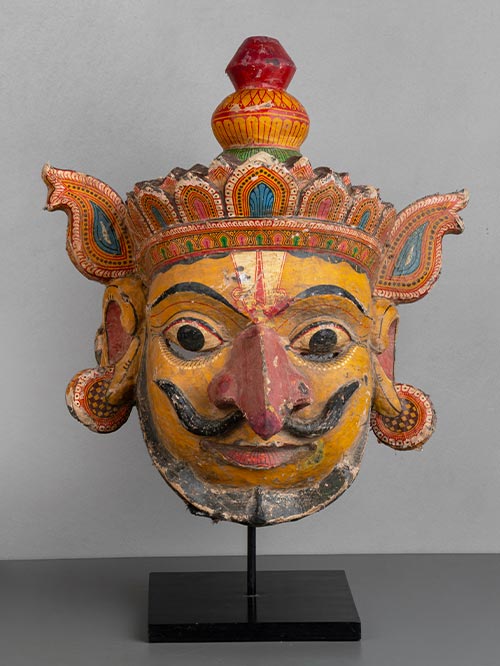
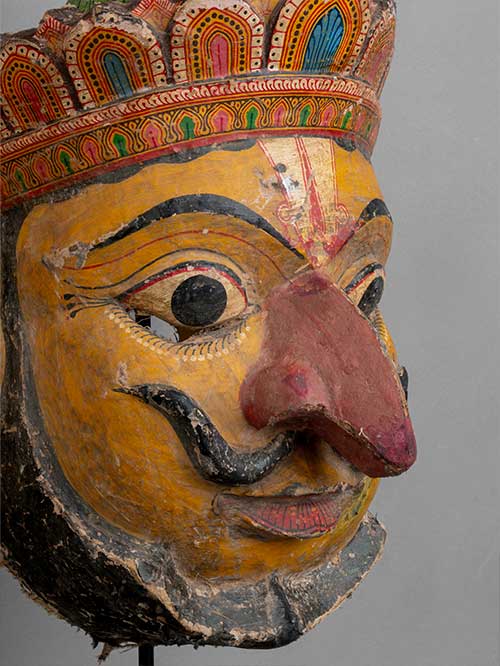
Orissa
Wood, polychromed
A magnificent and rare Ramlila festival mask from Orissa, in excellent condition with original colour and patina. Notable features include a Vaishnavite tilak (mark), a tiered crown with geometric and floral motifs and an upturned moustache emanating from a large beaked nose. Two large earrings with decorative swirls hang from his elongated ears and tiny ovular slits have been cut out beneath the eyes to help the dancer navigate while wearing the mask.
Garuda is often shown as the mount of Vishnu. He was originally (in the Rig Veda) regarded as the sun in the form of a bird but this association was taken over by Surya. His earliest appearance in Indian sculpture was as a mythical bird forming part of the animal kingdom paying homage to the Buddha. The necessity of emphasising its mythological aspect resulted in characteristic distortions of its form combining sometimes a parrot like beak and human elements and wearing ear-rings. By the end of the Pallava period the bird element in his appearance had shrunk to a beak-like nose and wings attached to an otherwise human body. In this form he is usually shown with two hands (often in anjali mudra).
Shahi Jatras (royal processions) of Orissa present different episodes from the Ramayana during the spring season, usually lasting for for one week. Actors, carrying huge wooden masks and gorgeous costumes, walk on the streets with stylized gait and mime with the accompaniment of loud drumming. The Desia Nata of Koraput, Orissa, also uses masks for representing gods, goddesses, animals, birds and demons. These themes are also taken from Ramayana.
Mask Size (cms): 55(H) x 48(W) x 28(D), 66(H with stand)
Mask Size (inches): 21.5(H) x 19(W) x 11(D), 26(H with stand)
-
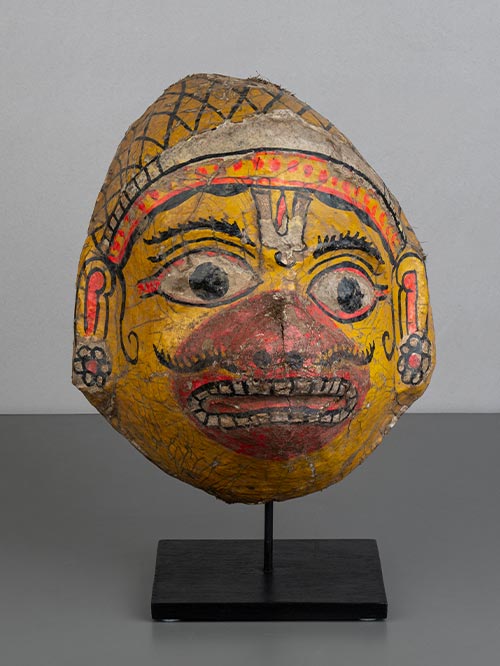

Cheriyal, Warangal (Telangana)
Pigment painting and lacquer on cloth and wood
This decorative mask depicts Hanuman, who is a popular deity who is worshipped all over India. This mask would have been a part of a set employed in the narration of myths and legends by the Yadavs or Dhangars, a community which is generally pastoral. These itinerant performers traveled from village to village, providing a welcome storytelling break for farmers. Their performances allowed marginalized castes to hear tales of the gods. They commissioned painted cloth panels, models, and masks from Cheriyal scroll painters to aid their storytelling.
Cheriyal masks, typically made from Ankudu wood and sawdust, undergo an intricate crafting process. The wood is shaped, smoothed, and treated with khadi cotton mixed with rice starch, white mud, tamarind seed paste, and gum water. Artists then sketch and paint using natural dyes. After drying, a lacquer layer is applied for a glossy finish and paint protection
Mask Size (cms): 30(H) x 15.5(W) x 20(D), 37(H with stand)
Mask Size (inches): 12(H) x 6(W) x 8(D), 14.5(H with stand)
-
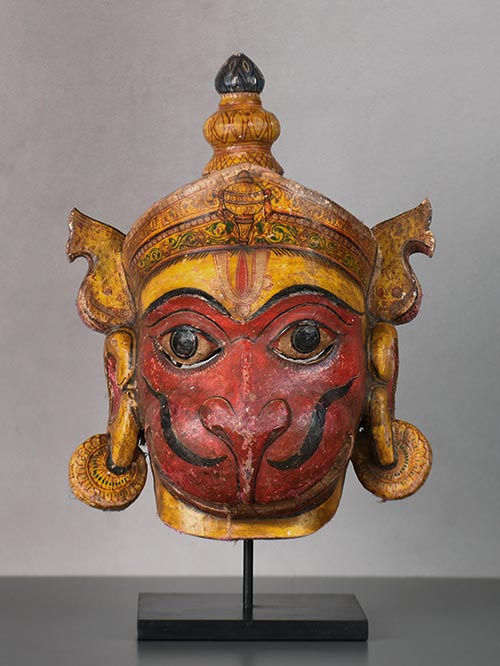

Orissa
Wood, polychromed
A decorative Hanuman festival mask from Orissa in good condition, retaining its original color and patina. The mask features a tiered crown, intricately detailed and painted, with a pair of makaras on either edge. At the center of the crown, amidst floral and geometric decorations, is a painted mace, Hanuman’s weapon of choice. The mask is marked with a prominent Vaishnavite tilak on Hanuman’s forehead. The anthropomorphic Hanuman is depicted with a prominent mandrill, rows of exposed teeth, and a long curling moustache. Tiny ovular slits beneath the eyes facilitate navigation for the dancer while wearing the mask.
Hanuman is a popular deity who is worshipped all over India, particularly in villages and in the South. His story is found in the Ramayana where he is the ubiquitous servant of Rama, the epitome of devoted service and loyalty. His search for the heroine Sita, captured by Ravana, illustrates his superhuman powers and zealous performance of the tasks that were given to him.
Shahi Jatras (royal processions) of Orissa present different episodes from the Ramayana during the spring season, usually lasting for for one week. Actors, carrying huge wooden masks and gorgeous costumes, walk on the streets with stylized gait and mime with the accompaniment of loud drumming. The Desia Nata of Koraput, Orissa, also uses masks for representing gods, goddesses, animals, birds and demons. These themes are also taken from Ramayana.
Mask Size (cms): 51(H) x 38(W) x 20(D), 58.5(H with Stand)
Mask Size (inches): 20(H) x 15(W) x 8(D), 23(H with Stand)
-
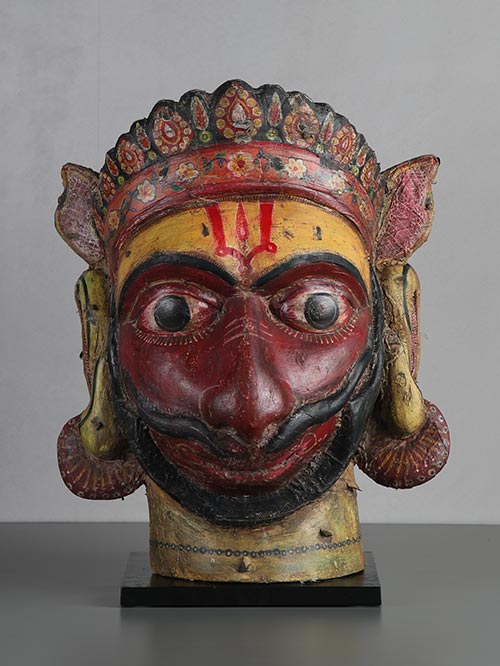
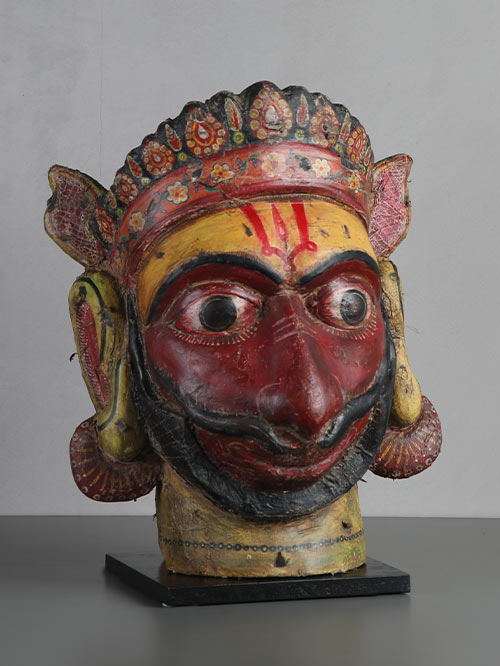
Orissa (Eastern India)
Wood, extensively polychromed
A magnificent and rare processional head in good condition with original colour and patina
Hanuman is a popular deity who is worshipped all over India, particularly in villages and in the South. His story is found in the Ramayana where he is the ubiquitous servant of Rama, the epitome of devoted service and loyalty. His search for the heroine Sita, captured by Ravana, illustrates his superhuman powers and zealous performance of the tasks that were given to him.
Shahi Jatras (royal processions) of Orissa present different episodes from the Ramayana during the spring season, usually lasting for for one week. Actors, carrying huge wooden masks and gorgeous costumes, walk on the streets with stylized gait and mime with the accompaniment of loud drumming. The Desia Nata of Koraput, Orissa, also uses masks for representing gods, goddesses, animals, birds and demons. These themes are also taken from Ramayana.
Size (cms): 56(H) x 46(W) x 43(D)
Size (inches): 22(H) x 18(W) x 17(D)
-
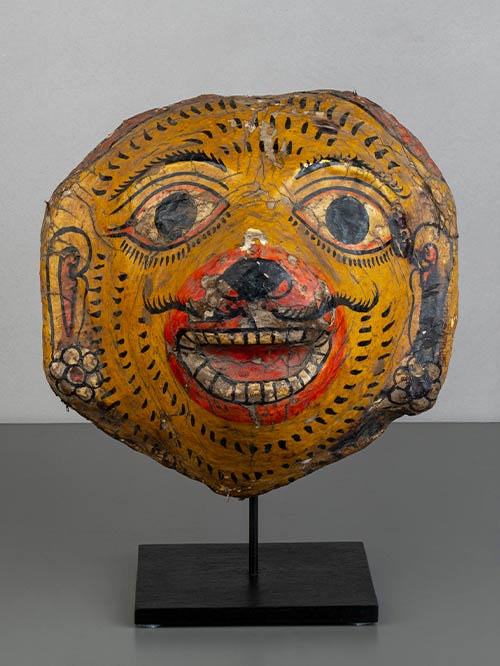

Cheriyal, Warangal (Telangana)
Pigment painting and lacquer on cloth and wood
This decorative mask depicts Jambavan, the King of the bears and an ally of Lord Rama in the battle of Lanka. This mask would have been a part of a set employed in the narration of myths and legends by the Yadavs or Dhangars, a community which is generally pastoral. These itinerant performers traveled from village to village, providing a welcome storytelling break for farmers. Their performances allowed marginalized castes to hear tales of the gods. They commissioned painted cloth panels, models, and masks from Cheriyal scroll painters to aid their storytelling.
Cheriyal masks, typically made from Ankudu wood and sawdust, undergo an intricate crafting process. The wood is shaped, smoothed, and treated with khadi cotton mixed with rice starch, white mud, tamarind seed paste, and gum water. Artists then sketch and paint using natural dyes. After drying, a lacquer layer is applied for a glossy finish and paint protection
Mask Size (cms): 28(H) x 18(W) x 21(D), 34(H with stand)
Mask Size (inches): 11(H) x 7(W) x 8.5(D), 13.5(H with stand)
-
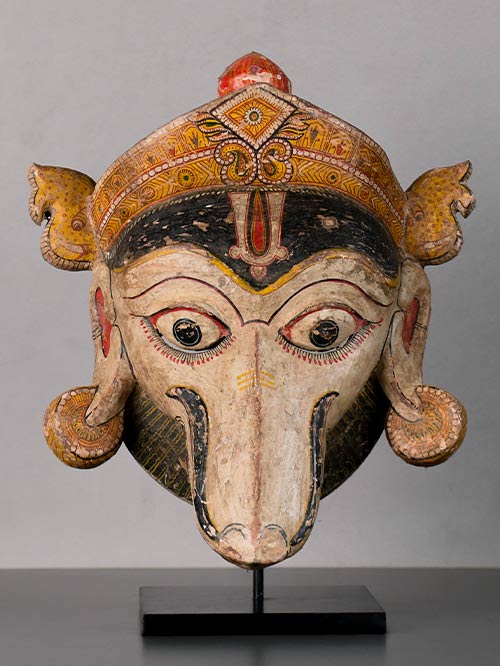
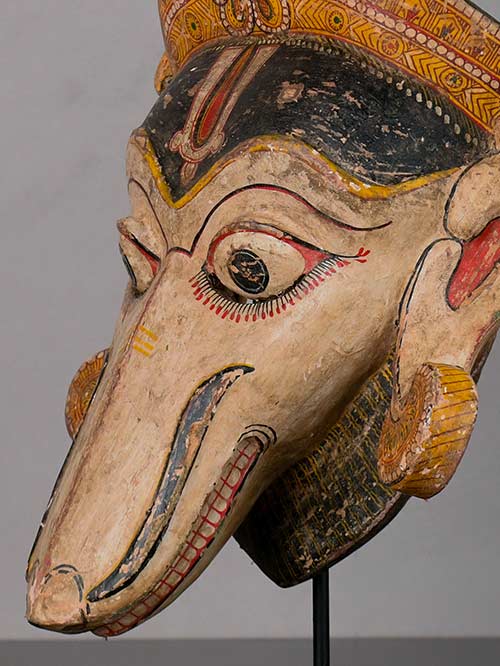
Orissa
Wood, polychromed
This delicately painted dancing mask of Jambavan. Jambavan was the King of the bears and an ally of Lord Rama in the battle of Lanka His wears an elaborate painted crown and a pairs of ear ornaments. A prominent vaishnavite naman adorns his forehead and his elongated curly moustache runs along his snout. The mask would have been used during folk performances of the Ramalila in Orissa.
Shahi Jatras (royal processions) of Orissa present different episodes from the Ramayana during the spring season, usually lasting for for one week. Actors, carrying huge wooden masks and gorgeous costumes, walk on the streets with stylised gait and mime with the accompaniment of loud drumming. The Desia Nata of Koraput, Orissa, also uses masks for representing gods, goddesses, animals, birds and demons. These themes are also taken from Ramayana.
Mask Size (cms): 54.6(H) x 45.7(W) x 26(D)
Mask Size (inches): 21.5(H) x 18(W) x 10(D)
-
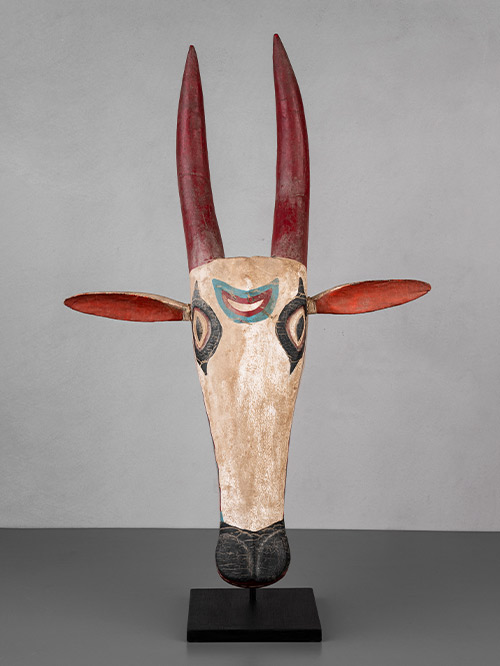
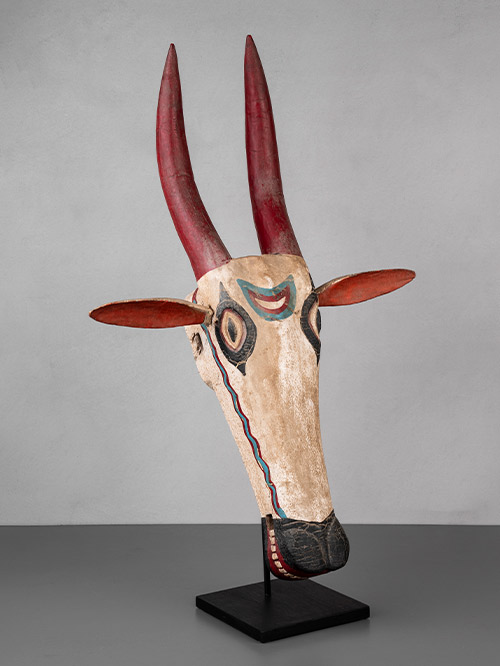
Kerala
Wood, polychromed
A finely painted Nandi festival head.
These heads are used in bull festivals known as kala velas. Bull festivals originated out of people’s desire to keep their bulls, bullocks and oxen healthy as they were used for ploughing and other work. In a society whose well-being was linked to good and bountiful crops and who therefore sought the benevolence of nature, these animals played a major role. The idea was to make an offering of them to their local deity- Bhagavathi. Their importance can be realised by the fact that at Mulayankavu there are forty pairs of these effigies at both the main festival in the Malayalam month of Medam (mid-April to mid-May) and their other festival in Meenam (mid-March to mid-April). The difference is that in Meenam there are also eleven single bullocks belonging to particular families in the area. These festivals are exclusive to the region of northern Kerala known as Valluvanad, formerly a small kingdom.
Mask Size (cms): 86.5(H) x 59(W) x 14(D), 92.5 (H with stand)
Mask Size (inches): 34(H) x 23(W) x 5.5(D), 36.5 (H with stand)
-


Orissa
Wood, traces of polychroming
An impressive Rakshasa mask painted with bulging eyes and a fanged mouth. His hair is tied in the characteristic topknot worn by Rishis indicating that the demon is in a disguised form to lure in unsuspecting victims. This mask would have been used during folk reenactments of the Ramlila in Orissa.
‘Rakshasa or demon is a generic term for a malevolent spirit. The Rakshasas roam at night, preferably in the dark half of the month or on the night of the new moon, assuming many forms at will. They were powerful warriors, expert magicians and illusionists. As shape-changers, they could assume various physical forms, and it was not always clear whether they had a true or natural form.
Shahi Jatras (royal processions) of Orissa present different episodes from the Ramayana during the spring season, usually lasting for for one week. Actors, carrying huge wooden masks and gorgeous costumes, walk on the streets with stylized gait and mime with the accompaniment of loud drumming. The Desia Nata of Koraput, Orissa, also uses masks for representing gods, goddesses, animals, birds and demons. These themes are also taken from Ramayana.
Size(cms): 49.5H) x 33(W) x 23(D), 56(H with stand)
Size(inches): 19.5(H) x 13(W) x 9(D), 22(H with stand)
-
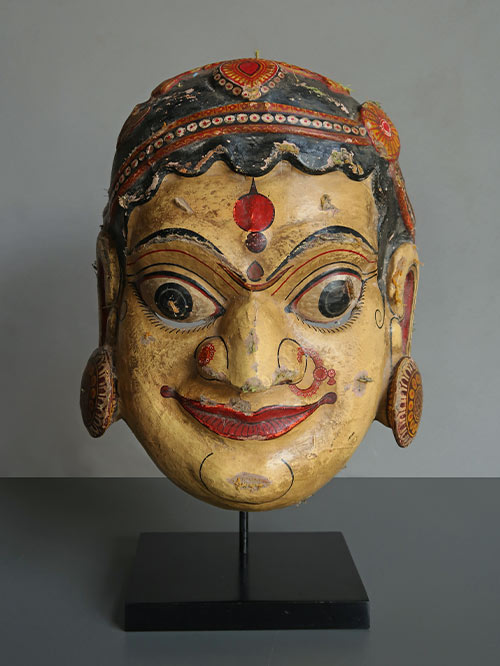
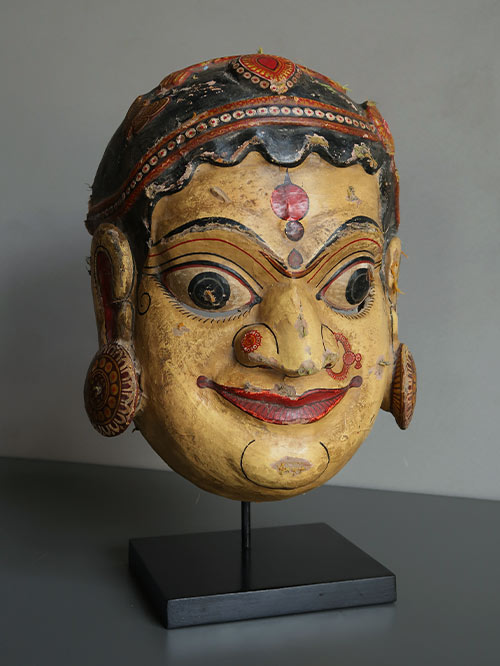
Orissa
Wood, extensively polychromed
This delicately painted and unusual dancing mask depicts Sita the consort of Lord Rama. Sita wear large kundala earrings and various nose and an unusual butterfly shaped hair ornament. A prominent tilaka adorns her forehead. Elongated slits have been cut out under her piercing eyes to help the dancer navigate while wearing the mask. This mask would have been used during folk performances of the Ramalila in Orissa.
The Ramalila (folk re-enactment of the life of Rama) is a widespread type of popular performance. The genre encompasses various dramatic enactments of the story of Rama by non-professional actors, men playing women’s roles, common throughout north India, ranging in duration from ten to thirty-one nights, concluding on the autumn holiday of Dussehra. In Orissa in particular, Ramalila is performed during the two weeks following Rama’s birthday, Ramanavami, in March or April, a time that makes sense for an enactment that begins with Rama’s birthday, on Ramanavami. This timing also coincides with the agricultural cycle, making the performance a celebration of the spring harvest. Also it is pleasant at the beginning of intense summer heat for villagers to enjoy the cool night hours with performances, generally from midnight till dawn, while actors and audience are free to sleep in the daytime.
Size with stand (cms): 40(H) x 27(W) x 22(D)
Size with stand (inches): 15.5(H) x 10.5(W) x 8.5(D)
-
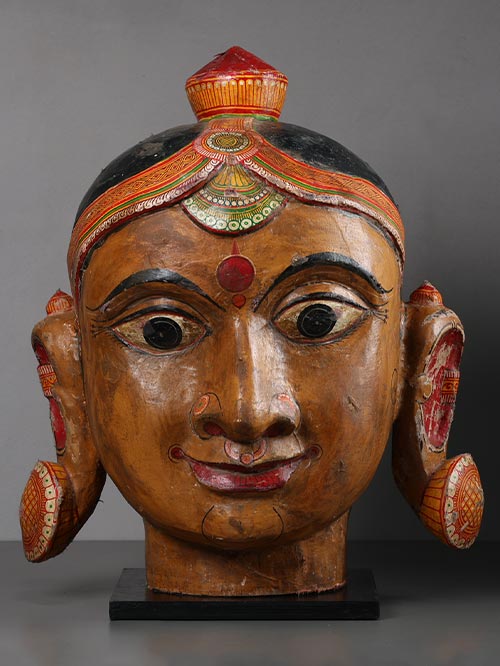

Orissa (Eastern India)
Wood, extensively polychromed
A magnificent and rare processional head in good condition with original colour and patina
Sita, is the central female character of the Hindu epic Ramayana and a daughter of King Janak of Janakpur. She is the consort of the Hindu god Rama (avatar of Vishnu) and is an avatar of Lakshmi (Aadi Shakti of Lord Vishnu), goddess of wealth and wife of Vishnu. She is esteemed as a paragon of spousal and feminine virtues for all Hindu women. Sita is known for her dedication, self-sacrifice, courage and purity.
Shahi Jatras (royal processions) of Orissa present different episodes from the Ramayana during the spring season, usually lasting for for one week. Actors, carrying huge wooden masks and gorgeous costumes, walk on the streets with stylized gait and mime with the accompaniment of loud drumming. The Desia Nata of Koraput, Orissa, also uses masks for representing gods, goddesses, animals, birds and demons. These themes are also taken from Ramayana.
Size (cms): 61(H) x 50(W) x 48(D)
Size (inches): 24(H) x 19.5(W) x 19(D)
-
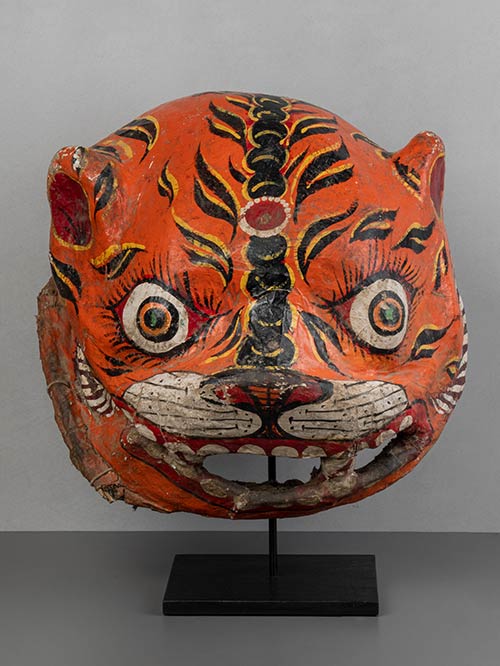

Southern Orissa
Papier-mâché, wood and cloth
The Bhaga Naacha (Tiger Dance) was once a popular and highly regarded unique folk dance form in Orissa. It used to be performed before and after hunting. Now it intricately associated with the Thakurani Yatra festival that is celebrated in the Ganjam district in Southern Orissa. The ritual festival celebrates the Mother Goddess Thakurani or Durga who also rides on a tiger or lion. Apart from Tiger, the Bull, Deer and Horse dance are also typical features of this region.
During the performance the dancers are surrounded by a group of Changu (drum) players who by beating the changus encourage them to dance. The dancers work in coordination under the cane frame concealed by a thick cloth richly decorated with mirrors and applique. The masks are bigger than the head with colourful traditional paintings and decorations. This fast and dynamic dance needs enthusiasm and energy not only for the dancers but also for the drummers and bell players. Acrobatic movements and hissing sound charm, captivate and excite the audience especially children. Although visibly it seems simple, it needs skills, energy, coordinated staging and skilled direction. The thematic variations within the dance include encounter between tiger and ox, encounter between tiger and hunter and tiger preying on horse etc.
Mask Size (cms): 63(H) x 67(W) x 34(D), 70(H with Stand)
Mask Size (inches): 25(H) x 26.5(W) x 13.5(D), 27.5(H with Stand)
-
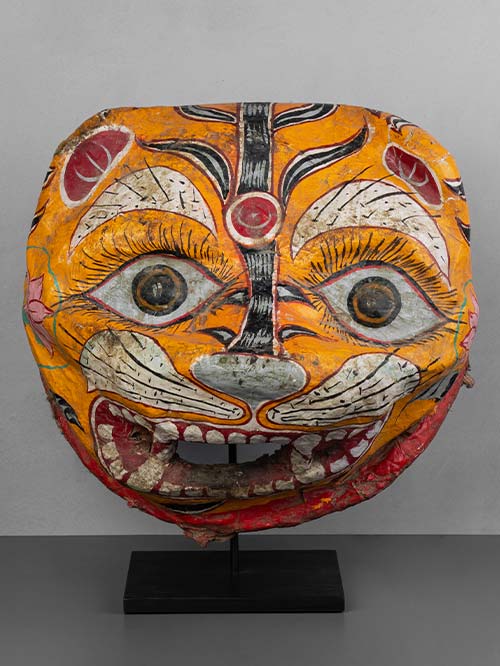
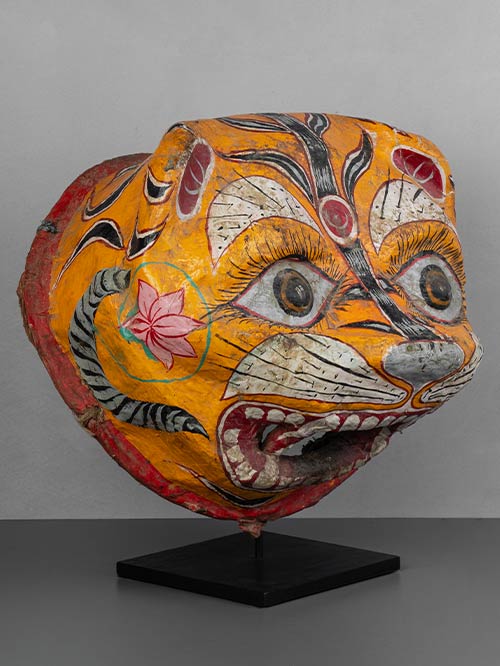
Southern Orissa
Papier-mâché, wood and cloth
The Bhaga Naacha (Tiger Dance) was once a popular and highly regarded unique folk dance form in Orissa. It used to be performed before and after hunting. Now it intricately associated with the Thakurani Yatra festival that is celebrated in the Ganjam district in Southern Orissa. The ritual festival celebrates the Mother Goddess Thakurani or Durga who also rides on a tiger or lion. Apart from Tiger, the Bull, Deer and Horse dance are also typical features of this region.
During the performance the dancers are surrounded by a group of Changu (drum) players who by beating the changus encourage them to dance. The dancers work in coordination under the cane frame concealed by a thick cloth richly decorated with mirrors and applique. The masks are bigger than the head with colourful traditional paintings and decorations. This fast and dynamic dance needs enthusiasm and energy not only for the dancers but also for the drummers and bell players. Acrobatic movements and hissing sound charm, captivate and excite the audience especially children. Although visibly it seems simple, it needs skills, energy, coordinated staging and skilled direction. The thematic variations within the dance include encounter between tiger and ox, encounter between tiger and hunter and tiger preying on horse etc.
Mask Size (cms): 63(H) x 67(W) x 34(D), 70(H with Stand)
Mask Size (inches): 25(H) x 26.5(W) x 13.5(D), 27.5(H with Stand)
-


Orissa (Eastern India)
Wood, extensively polychromed
A beautiful large polychromed wooden head of a Tiger painted yellow with large white and black bubris (stripes) and a characteristic candy cane moustache. In typical Orissan style, the tiger has large geometric earrings and a decorated tiered crown.
Shahi Jatras (royal processions) of Orissa present different episodes from the Ramayana during the spring season, usually lasting for for one week. Actors, carrying huge wooden masks and gorgeous costumes, walk on the streets with stylized gait and mime with the accompaniment of loud drumming. The Desia Nata of Koraput, Orissa, also uses masks for representing gods, goddesses, animals, birds and demons. These themes are also taken from Ramayana.
Size (cms): 76(H) x 56(W) x 47(D)
Size (inches): 30(H) x 22(W) x 18.5(D)
-

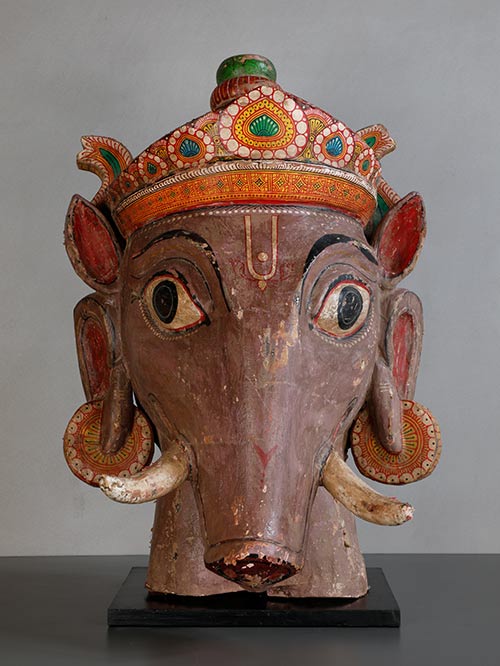
Orissa (Eastern India)
Wood, extensively polychromed
A magnificent and rare processional head in good condition with original colour and patina. Varaha is the third avatar of Lord Vishnu. He is usually depicted as half-human and half-boar, slaying the asura Hiranyaksha and carrying a conch shell, a discus, a mace, and a lotus flower in his four hands. He is considered to be the saviour of the world and the protector of the earth and his worship is believed to bring prosperity and good fortune.
Shahi Jatras (royal processions) of Orissa present different episodes from the Ramayana during the spring season, usually lasting for for one week. Actors, carrying huge wooden masks and gorgeous costumes, walk on the streets with stylized gait and mime with the accompaniment of loud drumming. The Desia Nata of Koraput, Orissa, also uses masks for representing gods, goddesses, animals, birds and demons. These themes are also taken from Ramayana.
Size (cms): 75.5(H) x 59(W) x 56(D)
Size (inches): 29.5(H) x 23(W) x 22(D)
-
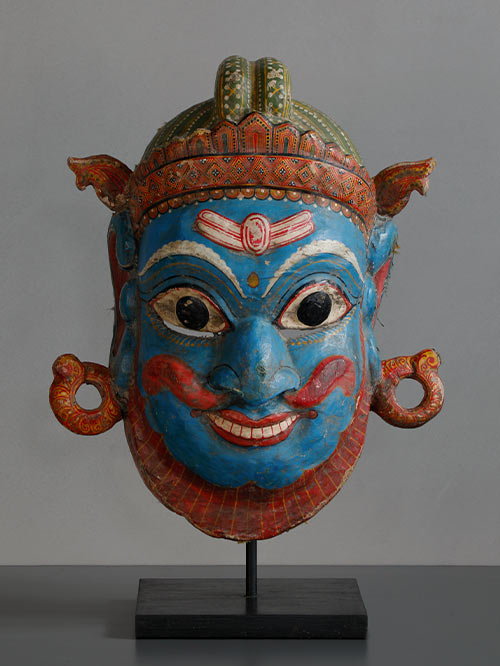
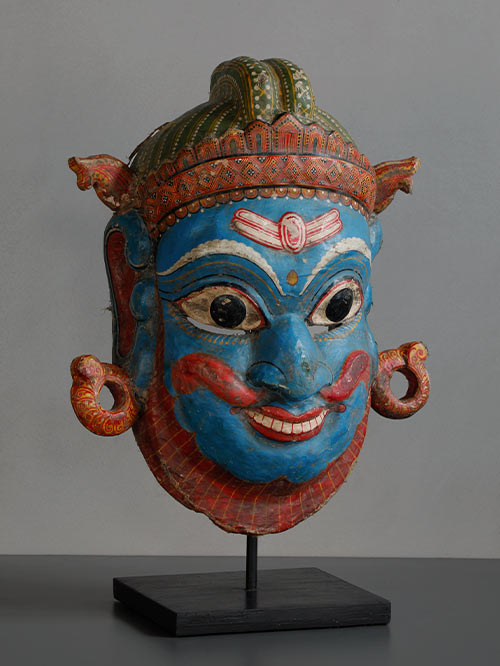
Orissa
Wood, extensively polychromed
An attractive dancing mask depicting the rakshasa Vibhishana. Painted in a brilliant blue, Vibhishana wears an elaborate turbaned crown decorated with geometric and floral patterns motifs and two large hooped earrings which dangle from his ears. Distinctive features include a prominent Shaivite tilaka, large piercing eyes and a joyous smile. The vibrant red twirling moustache and matching beard stands out on his blue skinned face. Ovular slits have been cut out beneath the eyes of Vibhishana to help the dancer navigate while wearing the mask.
Vibhishana, Ravana’s younger brother, was a rare good-hearted Rakshasa; he was beautiful, pious and assiduous in his religious observances. When Brahma granted him a boon, he asked never to swerve from the path of righteousness and to be illumined by divine knowledge. Vibhishana joined Rama in his campaign against Ravana, and helped Rama’s army to cross the ocean into Lanka. When invisible Rakshasas infiltrated Rama’s camp, Vibhishana caused them to become visible, and Rama’s monkey soldiers destroyed them. After Rama’s final victory over Ravana, the loyal Vibhishana was made king of Lanka.
Shahi Jatras (royal processions) of Orissa present different episodes from the Ramayana during the spring season, usually lasting for for one week. Actors, carrying huge wooden masks and gorgeous costumes, walk on the streets with stylized gait and mime with the accompaniment of loud drumming. The Desia Nata of Koraput, Orissa, also uses masks for representing gods, goddesses, animals, birds and demons. These themes are also taken from Ramayana.
Size(cms): 43(H) x 34(W) x 19(D), 51(H with stand)
Size(inches): 17(H) x 13.5(W) x 7.5(D), 20(H with stand)
-

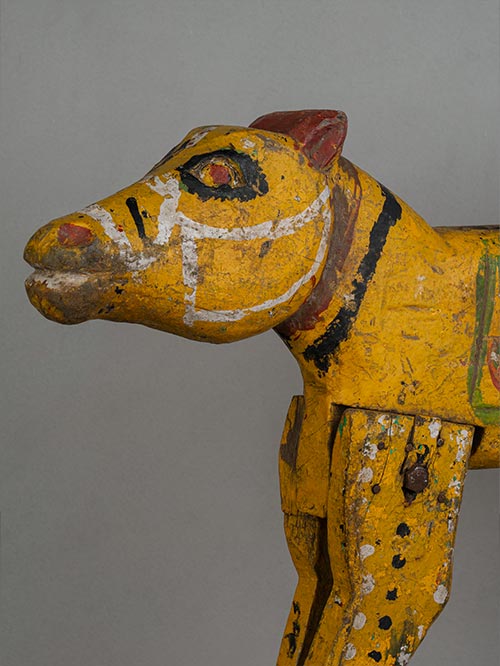
Maharashtra/Karnataka
Wood polychromed
An attractive folk carousel animal in the shape of a dog with original polychroming.
According to Hindu mythology, the dog was originally created by Brahma who then asked him to find and serve the greatest creature on earth. The dog, understandably, settled upon the elephant as his master. However, when he was rebuked for barking at night, lest he attract the attention of a lion, he realised he had made the wrong choice and decided to serve the lion instead. But the lion in turn complained that his bark would attract a hunter. Finally the dog found its right master, the hunter, who abided his barking without fear of a more powerful creature.
Size (cms): 50(H) x 70(W) x 10(D)
Size (inches): 19.5(H) x 27.5(W) x 4(D)

































